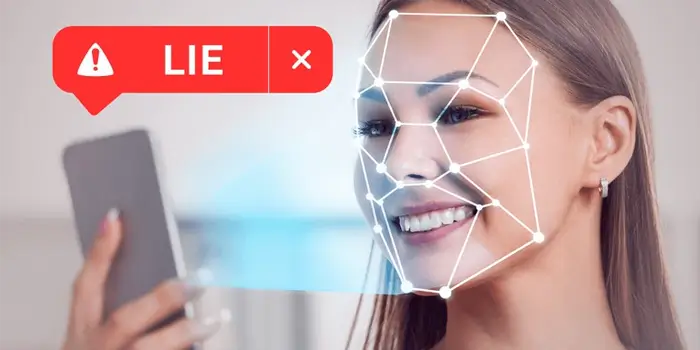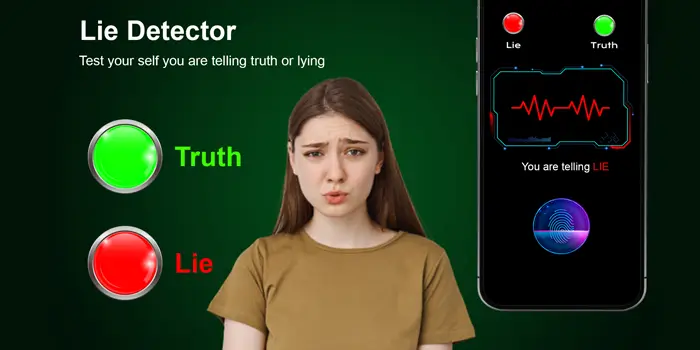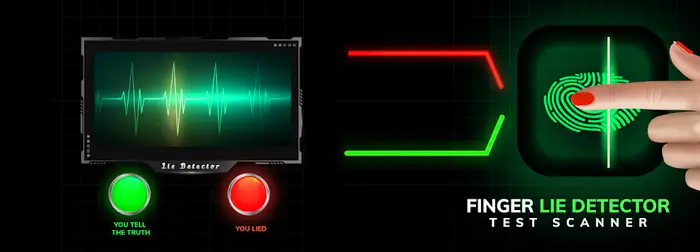
Lie detector apps are designed to mimic the function of traditional polygraph machines, with the intent of assessing the truthfulness of a person’s statements through physiological indicators. While professional polygraph tests measure responses such as cardiovascular activity, respiration, and skin conductivity, these apps typically rely on less sophisticated data inputs due to the constraints of smartphone sensors.
The basic premise of a lie detector app is rooted in the belief that certain physical reactions are associated with the act of lying, such as changes in voice stress or facial micro-expressions. The apps claim to detect these changes using a device’s microphone, camera, and sometimes additional peripherals. However, the accuracy and reliability of these applications are subjects of debate, as the interpretations of physiological data can be influenced by various factors beyond dishonesty, such as nervousness or excitement.
These applications often offer a more accessible and casual experience compared to the formal environment associated with traditional polygraphs. While they provide an interesting approach to the concept of lie detection, the scientific community generally agrees that lie detection—even with a polygraph—is not infallible. Therefore, the results from a lie detector app should be interpreted with caution, as they are not substantiated by the same level of scientific evidence as the polygraph tests conducted by trained professionals.
Fundamentals of Lie Detection
Lie detection is fundamentally predicated on the premise that technology can objectively assess physiological responses indicative of deception. This premise is rooted in the theory that the stress associated with lying triggers observable physical manifestations, such as changes in heart rate, blood pressure, respiration rate, and skin conductivity. The underlying assumption is that these involuntary physiological responses, when accurately measured and analyzed, serve as reliable markers of deceit.

As such, lie detection technologies are designed to capture and interpret these responses, providing an empirical basis to infer the likelihood of deception. This approach to lie detection hinges on the correlation between psychological stress and its physical correlates, leveraging scientific and technological advancements to operationalize this relationship for practical applications. However, the validity of these physiological measures as indicators of deception is contingent upon several assumptions about the uniformity of stress responses among individuals and the specific contexts in which lying occurs.
It presupposes a standard physiological response to the act of lying, which may not account for the variability in individual stress responses or the complexity of psychological factors influencing these reactions. Furthermore, the effectiveness of lie detection technologies is influenced by their ability to distinguish between stress related to deception and stress provoked by other factors, such as nervousness or fear of being falsely accused.
These challenges highlight the intricate interplay between psychological states and physiological responses, underscoring the necessity for ongoing research and refinement in lie detection methodologies to enhance their accuracy and reliability.
Polygraph Basics
A Polygraph test, commonly known as a lie detector, measures and records several physiological indices such as blood pressure, pulse, respiration, and skin conductivity while the subject answers a series of questions. The groundwork of polygraph testing is the assumption that deceptive answers will produce distinctive physiological responses that can be contrasted with those of non-deceptive answers.
- Components of a Polygraph
- Cardio: Measures heart rate and blood pressure
- Resp: Monitors breathing patterns
- EDA: Gauges skin conductivity or galvanic skin response (GSR)
Physiological Indicators
The physiological responses lie detector apps monitor are believed to indicate stress, which may be linked to deception. These include:
- Heart Rate: An increase can suggest stress or anxiety.
- Skin Conductivity: More sweating may alter the skin’s electrical properties.
- Respiration: Lying can cause more shallow breathing and higher respiration rate.
It is assumed that when a person is not telling the truth, they may experience heightened arousal leading to changes in these physiological processes. However, it’s crucial to understand that these indicators are not universally reliable and can be affected by various factors, such as nervousness or fear, not solely associated with deception.
Digital Lie Detector Technology
Digital lie detector technology embodies the cutting edge of deception detection, leveraging sophisticated software algorithms and enhanced sensor capabilities to significantly improve both the accuracy and efficiency of lie detection processes. This innovative approach integrates a myriad of physiological measurements—ranging from heart rate fluctuations to micro-expressions—captured through advanced sensors, and analyzes them using complex algorithms.

These algorithms are designed to identify patterns and inconsistencies that may indicate deceptive behavior. The digital evolution of lie detection technology not only augments the precision with which these indicators are assessed but also streamlines the entire process, enabling quicker, more reliable assessments. The integration of digital advancements into lie detection represents a significant leap forward from traditional methods, which relied heavily on human interpretation and simpler mechanical recordings.
By harnessing the power of machine learning and artificial intelligence, digital lie detectors can continuously learn from new data, thereby enhancing their diagnostic capabilities over time. This evolution reflects a broader trend towards the digitalization of various security and assessment tools, where accuracy, speed, and adaptability are paramount. The promise of digital lie detection technology to offer more nuanced and scientifically validated insights into human psychology and behavior signals a new era in the quest for truth, where technology plays a pivotal role in deciphering the complex web of human deceit.
Software Algorithms
Modern lie detector applications are powered by sophisticated software algorithms designed to analyze physiological and behavioral data for signs of deception. These algorithms take inputs like voice modulation, facial expressions, and eye movement, and process them using artificial intelligence (AI) techniques to detect inconsistencies or anomalies that may suggest a person is lying. Converus advertises its EyeDetect system as employing such technologies, claiming its utility in over 50 countries. A commitment to transformative lie detection is also embodied in entities like LiarLiar.ai, indicating a trend towards utilizing AI to advance this field.
Sensor Integration
The capability of software algorithms is greatly enhanced by the integration of sensors that collect real-time data. The sensors used in lie detection apps may include eye-tracking cameras, voice stress analyzers, and even posture detection tools. For example, EyeDetect relies on eye-camera technology. Additionally, methodologies such as AVATAR employ multiple sensors that monitor changes in eye behavior, voice, and posture to assess truthfulness, thereby providing a multifaceted approach to lie detection. This sensor integration allows for a comprehensive collection of data points, which when combined with advanced analytics, can offer a more complete profile of the subject under examination.
Operation of Lie Detector Apps
Lie detector apps operate by soliciting input from users, which is then subjected to a range of data analysis techniques to infer truthfulness. This input often includes voice recordings, responses to questions, or physiological data captured through the device’s sensors. The sophistication of these applications lies in their algorithmic prowess, employing methodologies such as voice stress analysis, linguistic content evaluation, and, in some cases, analysis of physical responses through connected wearable devices.

These algorithms scrutinize the submitted data for patterns and anomalies that research suggests may correlate with deceptive behavior. For instance, subtle fluctuations in voice pitch or hesitation in response times might be interpreted as indicators of lying, based on the app’s programmed criteria. The efficacy of lie detector apps in accurately determining truthfulness heavily relies on the robustness of their underlying data analysis techniques and the validity of the assumptions linking specific behavioral or physiological markers to deception.
These apps harness machine learning and artificial intelligence to refine their predictive capabilities, aiming to enhance their accuracy over time as they process more data. However, the complexity of human psychology and the variability in individual stress responses present significant challenges to the reliability of such applications. While these tools offer an intriguing application of technology in the quest for truth, their results are best interpreted with caution, given the current limitations in conclusively detecting deception through digital means alone.
User Interaction
When a user engages with a lie detector app, they typically begin by either verbally responding to questions or inputting responses through the device’s interface. Specific apps might require the user to take a photo or video, particularly those apps claiming to analyze facial cues for signs of deception. The user’s interaction is designed to be straightforward and requires minimal technical knowledge.
Data Analysis Process
The core of these apps lies in their data analysis process. Apps like EyeDetect work by analyzing involuntary eye movements to detect lies. Another app, VerifEye, claims to assess truthfulness through eye vibrations, while machine learning algorithms can evaluate muscle twitches and vocal fluctuations.
- Eye Movement Monitoring: Tracks involuntary eye behavior as potential deception indicators.
- Facial Analysis: Uses photos or live video to scan for micro-expressions typically invisible to the naked eye.
- Voice Stress Analysis: Listens for subtle frequency changes in the voice that may suggest dishonesty.
Apps use a baseline measurement from truthful responses to compare against when determining if a lie is being told. It’s important to note that while these apps incorporate high-tech methodologies, their accuracy can vary and should not be equated with professional polygraph results.
Lie Detection App Efficacy
The functionality and reliability of lie detector apps are surrounded by considerable skepticism due to the inherent complexities of human psychology and the technological limitations of non-professional devices. These applications claim to discern truth from deception by analyzing physiological and behavioral data collected through user interactions. However, the premise that specific patterns of physiological responses can universally indicate deceit overlooks the nuanced nature of human stress responses.

Factors such as anxiety, cultural differences, or the context in which a question is asked can all influence these responses, leading to potential false positives or negatives. Moreover, the capacity of smartphones and wearable technology to accurately measure and interpret such data is significantly constrained by their sensor capabilities, which are not designed for the sophisticated analysis required for reliable lie detection. Additionally, the reliability of these apps is further compromised by the challenges in developing algorithms capable of accurately interpreting complex human behaviors.
While advancements in artificial intelligence and machine learning offer some promise in improving analytical precision, these technologies require vast and diverse datasets to learn from. The potential for biases in training data, coupled with algorithmic limitations, raises questions about the apps’ ability to universally apply their findings across different populations. Given these substantial challenges, the use of lie detector apps in any serious or consequential context should be approached with caution. Users should be aware that the current state of technology does not yet support the high level of accuracy and reliability necessary for critical decision-making based on the detection of deception.
Accuracy Concerns
Lie detector apps, which often employ algorithms to assess truthfulness based on various inputs, face significant accuracy concerns. The science of lie detection suggests that human ability to detect lies is marginally better than chance, with even trained professionals achieving low levels of accuracy.
- Physiological Measurements: Apps may use physiological responses such as heart rate, which are measured and interpreted by algorithms. However, these responses can be affected by factors unrelated to lying, such as anxiety or excitement.
- Behavioral Signals: Some apps might analyze behavioral cues like eye movement or voice pitch. These signals are not consistent indicators of deceit since many honest individuals might display similar behaviors due to different reasons.
It should be noted that without the ability to understand context or individual psychological differences, apps are limited in their capacity to discern lies with high precision.
Ethical Considerations
The use of lie detector apps also raises ethical considerations, particularly in terms of privacy and consent.
- Privacy Risks: Apps that collect sensitive physiological or behavioral data might pose privacy risks if the data is not adequately protected or if it’s unauthorizedly shared.
- Consent Issues: The employment of such apps bears the question of whether all parties have consented to lie detection analysis, which is critical to ethical application.
Moreover, reliance on app results without corroborating evidence could lead to unfair consequences, emphasizing the need for careful consideration of these technologies’ outcomes.
The Future of Lie Detection
As traditional polygraph testing undergoes increasing scrutiny for its reliability and ethical implications, a wave of technological innovations is offering promising alternatives aimed at enhancing the accuracy and reliability of lie detection methods. These emerging technologies are diversifying the tools available for detecting deception, moving beyond the simple measurement of physiological responses to include advanced data analysis, artificial intelligence (AI), and machine learning algorithms.

By analyzing a broader range of indicators—from vocal nuances and facial micro-expressions to patterns in written communication—these new methods strive to capture the multifaceted nature of deception. This shift represents a significant advancement in the field, as it incorporates a more holistic approach to understanding human behavior, potentially overcoming some of the limitations faced by polygraph tests. Moreover, the integration of technology into lie detection endeavors not only aims to improve the scientific basis of these methods but also to make them more accessible and less invasive.
For instance, remote sensing technologies and non-contact measurement devices are being explored for their ability to detect signs of stress and deceit without the need for physical attachments to the individual being examined. This evolution towards less intrusive methods, coupled with the application of AI to analyze complex data sets for patterns indicative of deception, could revolutionize the field. As these technologies continue to mature, the prospect of deploying more accurate and reliable lie detection tools becomes increasingly tangible, marking a pivotal shift towards more scientifically robust and ethically sound practices in the quest to discern truth from deception.
Innovative Lie Detection Methods
- Eye Tracking and Pupilometry: Solutions now include sophisticated eye scanners that analyze eye movements and pupil changes. These methods are premised on the theory that cognitive effort and stress involved in lying affect the eyes.
- Voice Stress Analysis: Another alternative is voice stress analysis, which detects micro tremors in the voice that may indicate stress typically associated with deception.
- Facial Microexpressions: Researchers are exploring the use of technology to identify fleeting facial expressions, often imperceptible to the human eye, which can indicate deception.
- Thermal Imaging: Thermal cameras can detect heat patterns in the face that may change when a person is not telling the truth, based on the physiological response of blood flow.
- Kinesic Interview Techniques: This approach goes beyond verbal responses, focusing on body language and non-verbal cues that might suggest that someone is being deceptive.
- Future of Digital Truth Verification
- Artificial Intelligence (AI): AI algorithms are being developed to analyze multiple data points such as facial expressions, voice modulation, and body language to assess credibility.
- Machine Learning: Over time, as more data becomes available, machine learning allows these systems to improve their accuracy in distinguishing truth from lies.
- Real-time Analysis: Future systems could offer real-time analysis during interviews, providing immediate insights into the credibility of a subject’s responses.
- Non-invasive Sensors: Advancements may include non-invasive sensors that can monitor physiological signs without the subject’s awareness, potentially reducing the influence of the testing process on the results.

Comments (1)
Lukas Dartsays:
8 de abril de 2024 at 17:13Fantastic article, helped me a lot!